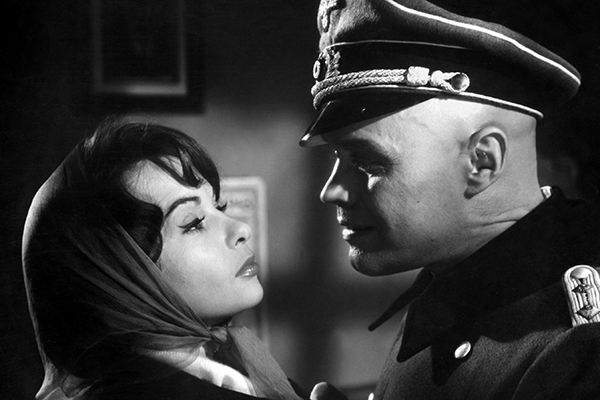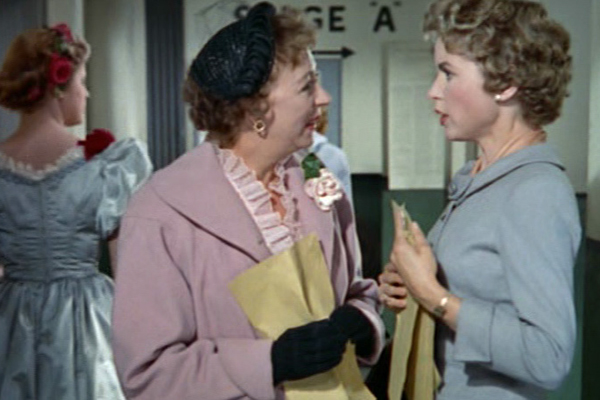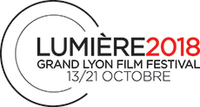Lumière festival 2018
by Serge Kaganski
Tuesday, October 16th
POSTED ON OCTOBER 17, 2018
On Tuesday, I continued my discoveries in Lyon with a filmmaker I knew nothing anything about until Lumière 2018, and another director who had made a good fifty films, of which I had seen only two.
This prolific and unknown filmmaker of mine, is obviously Henri Decoin, whose every film here is a glistening gem. What a pleasure to stroll untouched and beautiful cinematographic lands at the venerable age of 59! The wonder of the day was “The Face of the Cat” (aka “The Cat”), the nickname of the main character, a very sexy young woman (beautifully incarnated by Françoise Arnoul) who works clandestinely for a Resistance network and has a love affair with a Swiss journalist (who is in reality, and, unbeknownst to "the cat" a German officer and spy). To read this summary, one surmises that “The Face of the Cat” is not a comedy, to say the least. Far from the lightness and melting dialogues of “Beating Heart” or “Monelle,” “The Face of the Cat” is a tough film, ruthless, cut with a scalpel, drawn with the same somber and cold austerity that characterizes the style of Bresson or Melville. The dialogues here are stripped down to the bone of the essential, the image is dark, nocturnal, smoky, a reflection of the collective psyche of the time under Occupation. The actors are remarkable in their forbearance, restraint and clarity, and Françoise Arnoul is extraordinary as a heroine whose courage is on par with the men. Decoin also bets on the elegant eroticism of the actress with the feline face (in many scenes, she is putting on or taking off her stockings) since the erotic element is central to the plot of the film and the moral dilemmas it generates. Each scene is loaded with intensity and tension, ”The Face of the Cat“ is a film with not a gram of fat. Decoin ignited controversy shooting this film because he was criticized for having worked with the Continental during the war. If we can understand this by putting things back into the logically inflamed and raw post-war environment, it would have been a pity if Decoin could not make “The Face of the Cat;” we would have been deprived of an authentic masterpiece. Next we’d like to discover “The Cat Shows Her Claws” (not programmed at Lumière), centered on the same character.

Film : “The Face of the Cat”
After this huge surprise of a film, I went to introduce “Simon & Laura” by Muriel Box at Lumière Terreaux cinema. I would like to take this opportunity to salute the teams of the arthouse movie theaters of the city of Lyon (many of which have been taken over by the Institut Lumière, which fights on all fronts for the preservation of cinephilia and its ecosystem) and thank them warmly for their work and hospitality... “Simon & Laura” is an English cousin of Hollywood "screwball comedies," starring these saucy couples who never stop tearing themselves up and falling back on each other. The magnificent Kay Kendall and Peter Finch take on roles close to those of the Cary Grant, Katharine Hepburn, Carole Lombard or Clark Gable, projecting the same class, the same elegance in the conjugal storm. Muriel Box discreetly affirms her feminism by arming husband and wife with equal arguments, professions, and social status: the two characters are actors and it is rather he who is experiencing career difficulties - or to say it more directly, she is strong, he is weak. The other contribution of this film is a criticism as scathing as it is hilarious (and prophetic) concerning television. Indeed, the dueling couple receives an offer to be filmed in their daily lives, projecting an image of a close, happy household. So in 1955, Muriel Box was already pointing the way to the future of reality television and that’s not all… the obsession with ratings, the simulacrum of certain programs aimed at promoting a consensual morality and an artificial happiness. Both from the point of view of comedy and of social criticism, “Simon & Laura” absolutely deserves to be (re)discovered.

Film : Simon & Laura
The Lumière festival is not just about films: aside "good food" and "good friends" it’s also about still images, with photo exhibitions scattered throughout the city. Taking advantage of my free time after the Lumière Terreaux project, I visited the three Lumière galleries in the area. First, the Paul Grandsard exhibit in the Hangar du Premier-Film, featuring portraits from 2010-2017, allowing us to see Lumière guests staring straight at us, since they are tightly framed, their eyes boring frrom the lens. Among them, it is emotional to see Pierre Rissient again… Next, “Bob Dylan - Jerry Schatzberg,” devoted to the amazing and mythical surrenders of 1965-66 (a period of Dylan masterpieces Highway 61 Revisited and Blonde on Blonde) where Schatzberg has forever immortalized the genius at the flamboyant peak of his creativity and youth. Fabulous photos that we never tire of seeing again, and to which are added a sublime portrait of Faye Dunaway, a real sculpture in black and white, another splendid shot of an anonymous couple kissing in the back of a sedan or a shocking portrait of Sharon Tate in the bathtub, a few months before she was slaughtered by the madmen of the Manson sect. The third gallery offers images of Ingmar Bergman working on “Saraband” and staging for the theater, photos that portray the filmmaker's commitment to his work and the complicity with his favorite actors, Liv Ullmann and Erland Josephson. A photo exhibition is both close to and different from a film, it establishes a completely different relationship to the images, more meditative, leaving a bigger part to the imaginary, which gives us a break, and is a marvelous complement to the grand and long river of films presented by the festival.
The day concluded with a dinner at Le Passage (another HQ of the festival) in the presence of Bernard Lavilliers (who had just performed in the great hall of the Institut Lumière with a mix of poems, film excerpts and songs), the rare native of Saint- Etienne for whom Thierry Frémaux is willing to bury the footballistic hatchet (but just temporarily - we mustn’t get carried away!). Between dessert and (many) last glasses, Lavilliers, well lit, dissects his memories of cinema and throws out a film of which none of the venerable film-lovers present at the table have seen (Tavernier, Frémaux, Gerra, Christopher Thompson, journalist Laurent Delmas...): “Greaser’s Paradise” by Robert Downey (senior, the film dates from 1972). The movie is quickly Googled: “Greaser’s Paradise” does exist, but the Télérama site indicates that the film "has not been seen;" Allociné’s site mentions no cast or synopsis. Lavilliers reports having seen “Greaser’s Paradise” at midnight at the Trois-Luxembourg (one of the arthouse temples still standing in the Latin Quarter) summing up the affair as "a western on acid.” Described that way, it sounds promising! Decidedly, cinema is an inexhaustible reservoir of unchartered territories and lost paradises just waiting to be found!
Serge Kaganski

